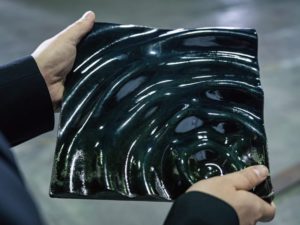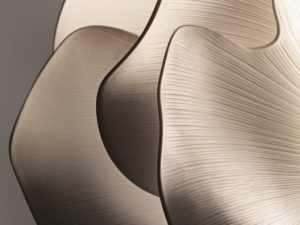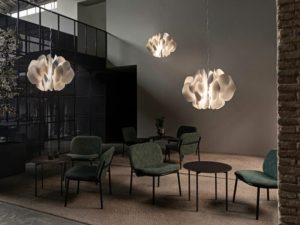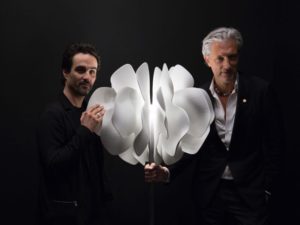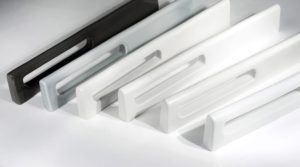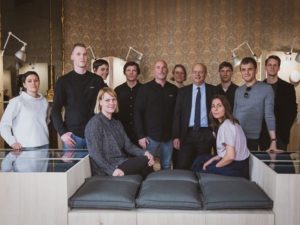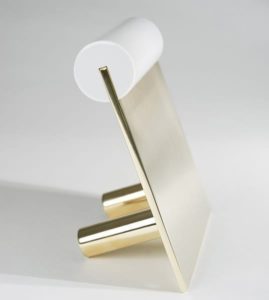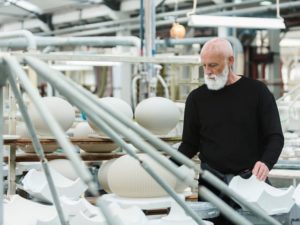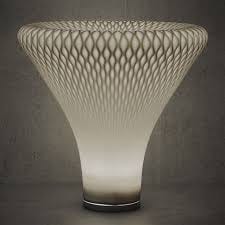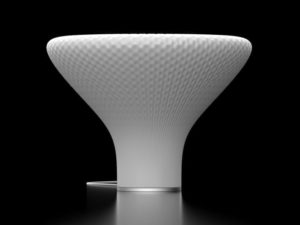Products Trends


Ceramics and interior design products | by Donatella Bollani
Cellular, foamy, translucent and transparent: research in the ceramic sector is proceeding at a rapid pace and over the next few years is likely to spawn a range of new-generation materials that will enormously expand the fields of application of this age-old material. A few recent applications in the fields of architecture and design illustrate just how much scope there is for the further development of ceramics, a material that is now widely adopted in architectural spaces in the form of large, thin panels.
Ready for printing
One of the latest experiments conducted by AGC, a world-leading producer of glass and hi-tech materials, has focused on the production of art objects thanks to the creative contribution of Japanese product designer Keita Suzuki.
In this project, art and latest-generation technology come together to challenge the formal limitations of both glass and ceramic.
The combination of high-precision additive manufacturing based on digital design and the intrinsic variability of the materials themselves makes each work unique. BrightorbTM is a moulding agent specially designed for 3D printing produced by AGC Ceramics Co. Ltd., one of the Group companies. This new material is a powder mixture consisting of tiny artificial ceramic beads (around 50 μm in diameter) combined with alumina cement that has previously been hardened by means of a humidification process.
The BrightorbTM layers are printed with a thickness of 0.1 mm each, after which a liquid agent is used to harden the printed areas. During the additive manufacturing process, each microlayer is deposited on top of the previous one to form the 3D object. While the technique has many possible applications, product design is certainly one of the most important fields of experimentation.
Ancient yet contemporary craftsmanship
The Chinese Tang dynasty (618-907 AD) used the term “white gold” to refer to a mixture of minerals such as kaolin, quartz and feldspar, which are still used today by the company Lladró to create up to 32 different kinds of high-quality porcelain for its extensive product portfolio.
The company’s experts and technicians develop chemical compositions, modelling methods and surface engraving and colouring techniques, while the team of artists and designers use the new processes to experiment with fresh interpretations of this age-old material.
A case in point is Marcel Wanders, who was commissioned by the Spanish brand to design Nightbloom, a collection of white porcelain lamps inspired by natural flower petals gently dancing in the wind.
The series of lamps (a ceiling pendant chandelier, a floor lamp, a desk lamp and a wall lamp) consists of a bouquet of petals decorated in delicate hand-sculpted 3D relief. These golden streaks diffuse a soft, iridescent light. Each piece is illuminated from its centre, the petal reliefs creating a colour tone that shines beauty onto any surface in the room.
The decoration is inspired by the ancient Japanese art of Kintsugi, a technique that uses a precious metal (such as liquid gold or silver or lacquer mixed with gold dust) to repair fragments of broken pottery while highlighting the pattern of cracks. Each repaired piece is rendered unique by the random nature of the seams and the irregularly branched decorations that are formed and accentuated by the metal.
Designed for hands
Kober, a leading German company that uses cutting-edge technology to produce high-quality porcelain articles, has carried out an experimental research project into the use of porcelain for handles, choosing the Italian brand Olivari as its partner.
Eleven designers from different regions of Germany were invited to develop new ideas and concepts for the use of this special material in conjunction with brass, a field in which Olivari boasts a high level of expertise. The result was an original and surprising collection of handles.
- IDO
- Olivari / Kober
Sarah & Henrik Böttger, Mark Braun, Uli Budde, Laura Jungmann, Kai Linke, Studio Niruk, Jonathan Radetz, Thomas Schnur, Martha Schwindling, Talbot & Mauloubier and Beate Wich-Reif were the designers who took part in this fascinating design exercise.
Amongst the many proposals, the IDO handle designed by Sarah and Henrik Böttger is particularly suitable for large sliding doors in public spaces due to its compact shape. The surface highlights the quality of porcelain and creates a solid, durable object that can be grasped in different ways. Circle by Studio Jonathan Radetz combines entrance area information with function in a ceramic surface. The Homage door handles by Design Studio Niruk are inspired by Bauhaus architecture and by the industrial production method of porcelain extrusion in strands.
- Circle
- Rito
- Homage
Part playful, part functional, the work of Martha Schwindling is inspired by the world of signage. The highly durable porcelain has a decorative function while transforming the handle and knob into an object that can be used in any location. Studio Kai Linke has developed Rito, a handle that serves as an interface between man and architecture. The round metal handle neck forms an oval shape, while the curved ceramic handle is pleasant and comfortable to touch. The intentional change of material from metallic to ceramic surfaces underlines the flowing form and high-quality workmanship.
A gift to humanity
Ross Lovegrove has also resumed his work with ceramics for the historic Portuguese porcelain manufacturer Vista Alegre.
E2H – Earth To Humanity is the name of the collection of lamps, reflecting the designer’s belief that porcelain is an extraordinary gift from the earth to mankind. Its properties and characteristics must be respected and at the same time challenged and revisited as part of a contemporary vision.
Inspired by the logic and beauty of nature, the British designer’s projects combine technology, materials science and an organic form to create a new language for industrial production.
His projects always reflect an approach that is at once deeply human and imbued with energy. This same optimism and innovative vitality permeate the three new award-winning lamps produced by Vista Alegre: Coluna, Blooming and Comtesse.
As Lovegrove commented on his experimentation and research work: “In the field of design I work more as a sculptor of materials and technology. (…) Remembering that ceramic as a material is one of the oldest companions of our imagination, an extraordinary gift from the earth to humanity. It has properties and physics which must be respected whilst at the same time being challenged by a new approach that only modern-day tools can reveal. So these designs converge shapes that seem influenced by nature’s beauty, made possible by a dedicated commitment to the digital age in which we live.”
August 2019





